Configuration Is Still Incorrect. Do You Want to Edit It Again? In Python
This article shows y'all how to use Python in VSCode. Yous learn how to run and debug your Python programs, and how to leverage the command-line inside VSCode to your reward. If you followed the tutorial, you've read a lot near IDEs and VSCode already. If not, you might want to start with these pages:
- how to write a simple Python program with Notepad
- Why you should use an IDE for Python programming
- How to install VSCode
- Which VSCode Python extensions y'all need for writing Python programs
- A tour of the VSCode GUI
Create or open a Python project in VSCode
A VSCode window ever shows i workspace. A workspace tin can, in plough, evidence multiple folders (or: projects) if you want it to. You can have multiple workspaces open, each in its own window. However, yous'll typically work on i project at a fourth dimension. When doing and then, ane window with one workspace will suffice.
Creating a projection is uncomplicated; it's a directory that you lot open up with VSCode. If you are on a terminal, and it doesn't matter if this is on Linux, MacOS, or Windows, you lot can create a new project and open up it with VSCode equally follows:
$ mkdir myproject $ cd myproject $ code .
The code command is a handy shortcut to open a VSCode window. If you lot prefer, you tin likewise open the binder from the bill of fare: File -> Open Folder .
The first time y'all open up a project with VSCode, the IDE creates a new file, .vscode/settings.json, with settings that are project-specific. If you lot utilise a version control system, yous may want to add the .vscode directory to the ignore list, since your coworkers probably have their ain settings and preference, or even use a completely different IDE.
 Thank you for reading my tutorials. I use ads to keep writing free manufactures, I hope y'all understand! Support me by disabling your adblocker on my website or, alternatively, buy me a coffee.
Thank you for reading my tutorials. I use ads to keep writing free manufactures, I hope y'all understand! Support me by disabling your adblocker on my website or, alternatively, buy me a coffee.
Run Python in VSCode
The following step-by-stride guide helps you lot to set VSCode correctly for running Python code.
Stride 1: Select python interpreter
A organization tin have multiple Python interpreters. It's of import to use the right interpreter for your project since VSCode uses information technology not only to run and debug your code simply also to provide things like car-completion. VSCode usually does its all-time to find the available Python interpreters automatically. In fact, VSCode even detects a virtualenv in your project binder. That virtualenv as well contains a Python interpreter, for example, which VSCode can use. In addition, information technology also supports enhanced virtual environment managers such as Pipenv.
Command palette
To gear up the interpreter, we'll apply a characteristic called the command palette. The control palette gives you quick admission to all functionality VSCode has to offer. It allows you to do almost everything with just your keyboard. It'due south awesome and a real timesaver, so I suggest y'all get used to it early.
The shortcut 'Control + shift + P' (Windows/Linux) or cmd + shift + P (MacOS) allows you to quickly open the command pallet. If there's one shortcut y'all need to acquire, it's this one! Alternatively, yous can utilise the carte du jour: "View -> Command Pallet…"
With the command palette open, start typing 'Python: select interpreter'. You'll quickly see that the auto-consummate helps y'all out; you don't have to type the unabridged text:

Preferably, you choose the interpreter from your virtual environs if you are using i. If not, pick an appropriate version. If you don't know which one to pick, cull Python 3 with the latest version.
If y'all don't have any selection, make sure you have Python installed on your organization and opt to manually enter the path to your interpreter. Y'all shouldn't have to; VSCode should be able to find a correctly installed Python interpreter.
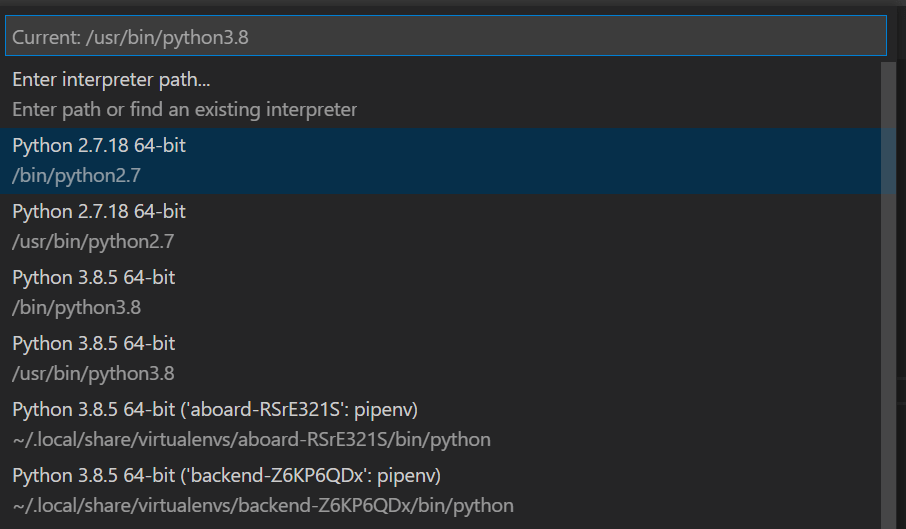
In Windows, this looks similar this:
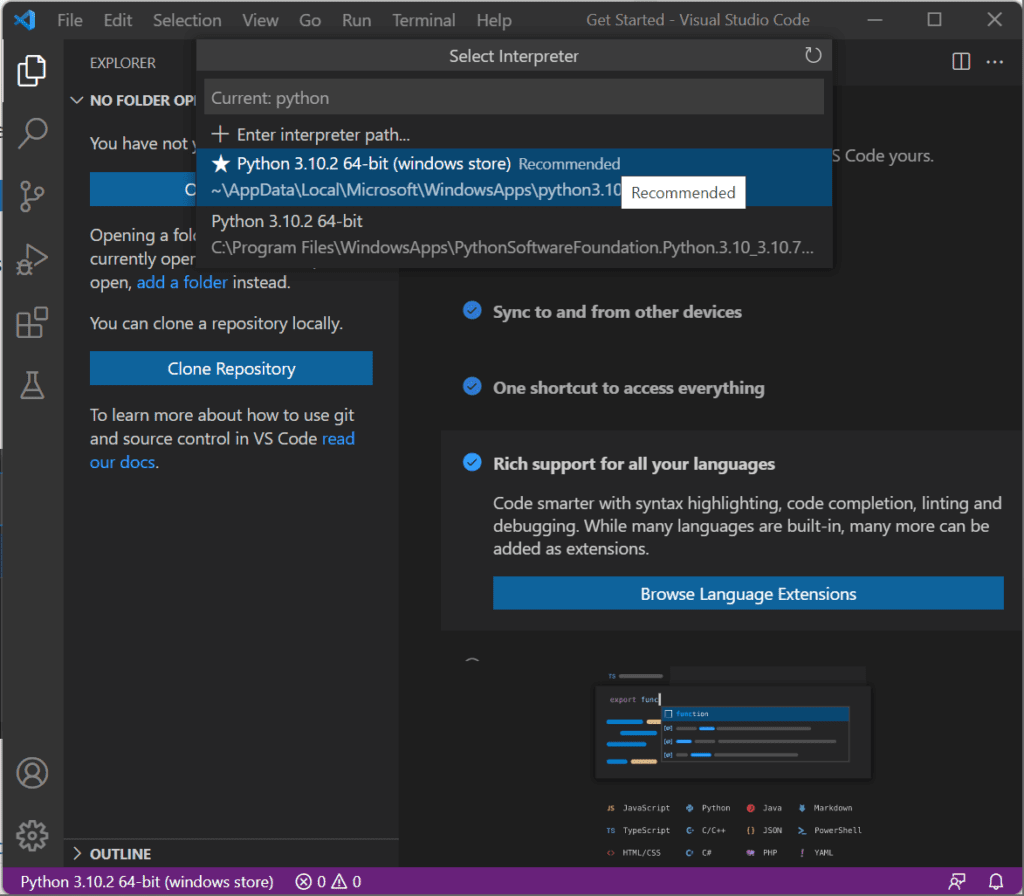
Step two: Create new Python project in VSCode
When yous open VSCode for the first fourth dimension, y'all'll kickoff with an empty workspace. Let's open a folder in which we can offset experimenting start. I created 1 beforehand, but yous can use the 'Open Folder' dialog to create one in identify besides. How this works exactly differs per OS. In Windows, you lot can click 'New folder', for example:
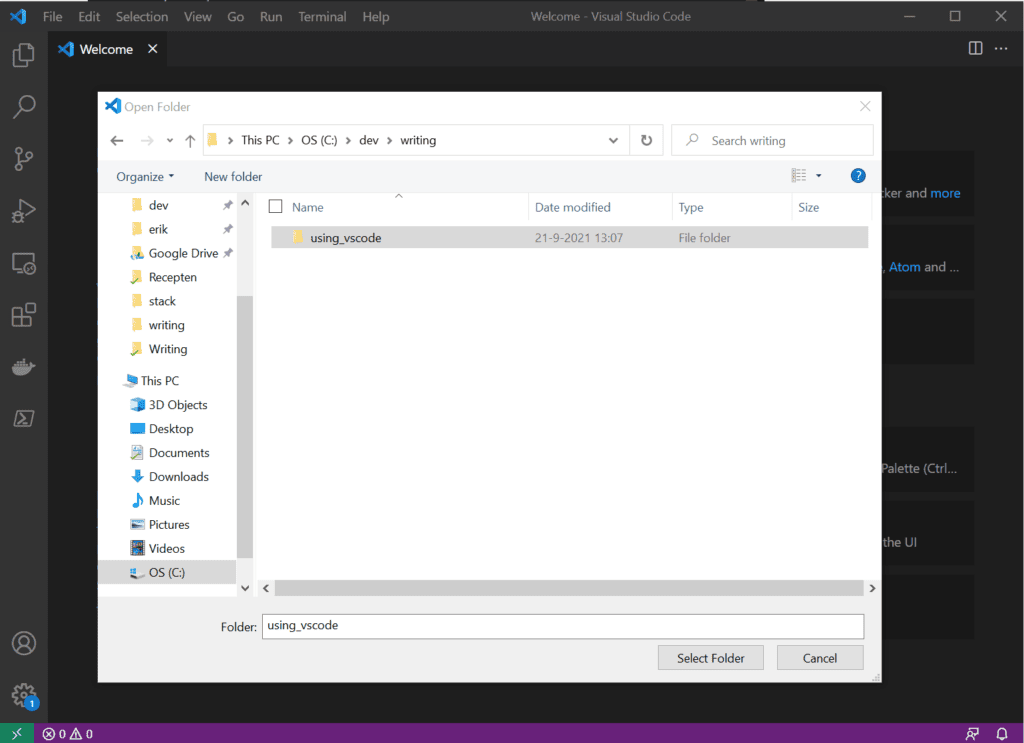
Step 3: Create and run a Python file in VSCode
With the interpreter configured, nosotros can now run a Python program. Allow's create a simple program, for testing purposes. Create a new file by clicking the 'new file' push in the explorer at the left, or using the File menu. Call it anything you like, I called mine vscode_playground.py. If y'all haven't already done then, VSCode might inquire you lot to pick a Python interpreter at this point. Get alee and pick ane.
Copy and paste the following plan into your newly created file:
import sys if len(sys.argv) == 1: proper noun = sys.argv[1] else: name = 'stranger' print(f'Hello there, {proper name}') This lawmaking will see if the script received an argument. If so, it assigns that to the name variable. If non, information technology will telephone call y'all a stranger. I deliberately fabricated a fault that we will try to debug later on.
To run this file, you tin can either apply the menu Run -> Run Without Debugging or press Command + F5 (Windows and Linux) or cmd + F5 (MacOS). What happens next, is VSCode opening an integrated terminal window in which the file is run. Since we fabricated a deliberate mistake, you should get an error similar to:
Traceback (most recent call terminal): File "vscode_playground.py", line 4, in <module> proper name = sys.argv[i] IndexError: list alphabetize out of range
This is what this looks like on Windows:
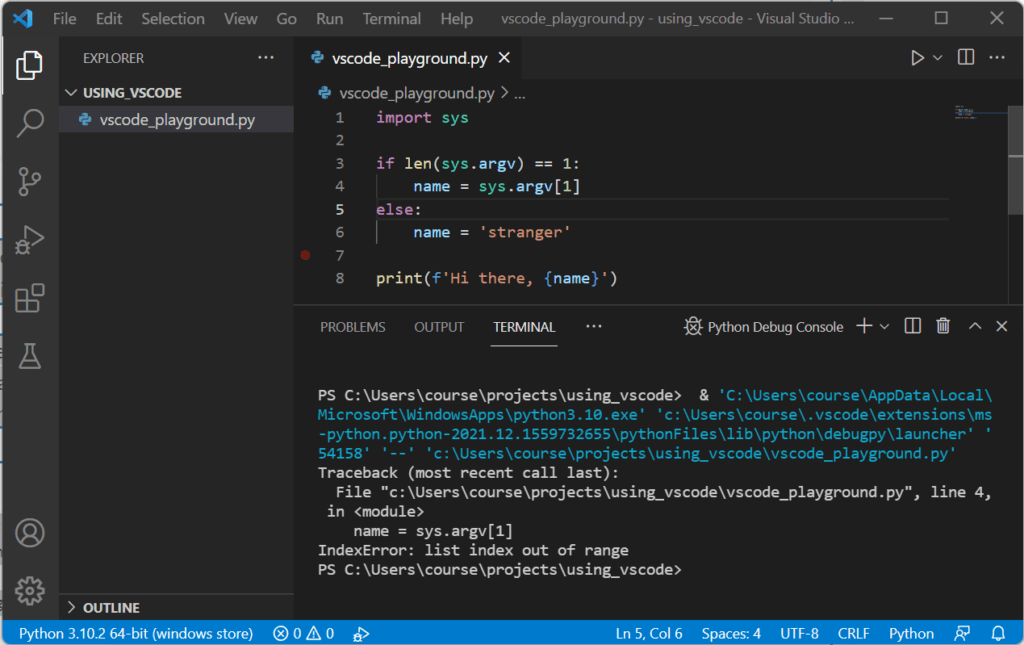
Debug Pyhon in VSCode
Debugging is one of those features that makes an IDE more powerful than a simple editor. It'southward not hard to practise and tin salvage you many hours of aimlessly adding print statements to your code. So let us spend a picayune effort on learning the basics right now!
Debug current file
Instead of using the 'Run Without Debugging' option, we'll now get for the 'Run -> Commencement Debugging' pick. Alternatively, you can but press F5. VSCode will ask y'all what you want to exercise. Since we desire to run the current file, choice 'Python File'.
The programme will over again crash with an mistake. Only instead of stopping, the debugger comes in and highlights the line in which the mistake occurred. Since information technology'south complaining well-nigh the list index beingness out of range, permit's inspect the sys.argv list more closely!
When hovering over the text sys.argv, you get a popover that allows you to inspect the variable in detail. When hovering over sys, you will see lots of internals from the sys module. When hovering over argv, you'll encounter the contents of argv:

Fifty-fifty though we didn't supply an argument, argv still contains ane element: the complete path to the current script. Something we didn't anticipate! The Bone always gives us the name of the programme itself every bit a first argument in argv. All we demand to do at present is change the comparing to: if len(sys.argv) == 2. Restart the program by pressing on the restart button at the top right, or past pressing Control + Shift + F5 or cmd + shift + F5. It should now output 'Hi there, stranger' and exit normally.
Create run configurations
Yous've learned a quick method to offset debugging by running the current file. If you want more options, however, you tin can create one or more run configurations. Such a configuration allows you to store specific parameters and such, then we can kickoff the program exactly how nosotros want information technology to.
To create a run configuration, click Run -> Add Configuration. Pick the 'Python file' option again. VSCode will create a launch.json file in the .vscode folder. This file is prefilled with an example configuration. Change the JSON to await like this:
{ "version": "0.2.0", "configurations": [ { "name": "Run with statement", "type": "python", "request": "launch", "program": "vscode_playground.py", "console": "integratedTerminal", "args": ["Erik"] } ] } This configuration supplies an argument to the script: the name 'Erik'. Notation that it too specifically starts vscode_playground.py instead of the current file. You can now launch the debugger using this configuration. Merely first, allow'southward open the Run/Debug view in the panel on the left, by clicking on the big run push with the little issues on it, or clicking Ctrl+Shift+D or Cmd+Shift+D:
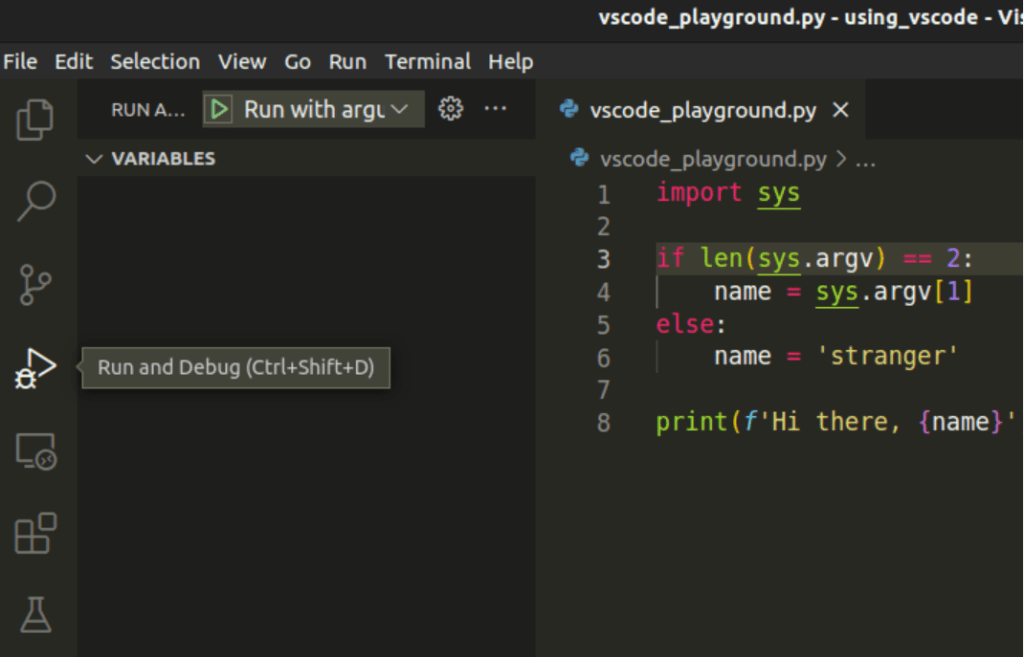
At the acme of this view, you should see your newly created configuration. Starting time information technology by clicking on the play button adjacent to it. The output should now say 'Howdy there, Erik'.
Breakpoints
At some signal, you lot want to employ so-called breakpoints: a line in your programme at which you want to explicitly pause the execution, or take a intermission, and then you become a chance to inspect the state of your program at that point. Calculation a breakpoint is extremely easy. In the so-called gutter, the infinite at the left of a file where the line numbers are displayed, you can click correct before a line number. A vague red dot should appear when y'all hover at that place, and it will plough bright cherry once you click it:

If you run the program at present, information technology volition pause on the breakpoint, assuasive you lot to audit the variables at that betoken in time. To continue, you lot can click the continue push or press F5. The debugger will proceed execution until information technology encounters another breakpoint or the program finishes.
Alternatively, yous tin execute the program step by step from here on, by using the step over (F10), step into (F11), and step out (F12) buttons. This way, you can execute the program line past line, and optionally step into and out of Python function calls.
Y'all now have a solid base level of knowledge to start debugging in VSCode. For more details, I'd like to refer you to the debugging section of the VSCode documentation, which should exist an splendid continuation of what I've taught yous and then far.
Run selection or current line
Some other helpful feature is the ability to run a pick of lawmaking or the electric current line you're on. This won't always exist useful: often, a line of code or selection of lawmaking heavily depends on its context. But sometimes, it can come in handy. To run a choice of code or the electric current line, printing Shift+Enter or use the command palette and search for 'run selection in terminal'.
The code runs in a Python REPL, and one time finished, this REPL stays open up then you can experiment, audit variables, etc. For example, if you 'run' a function, y'all can now call that function from the REPL since it is defined there.
A cool feature is that all subsequent commands to run a selection or current line are executed in this aforementioned REPL, keeping the land intact. So if you change the function and 'run' it again, the function gets redefined in the REPL. Information technology's a nice hack to test the code you just wrote, but it's not a replacement for proper unit testing.
Running code from the terminal
VSCode has an integrated terminal, which can be extremely useful. Some people never use it, and others use it all the time. I'1000 office of that last group: I run my code from the control line unless I'thousand debugging. I also do version control on the control line. I find information technology very useful to be familiar with all the command-line tools. It allows me to perform the crucial tasks without an IDE, due east.g., on someone else'due south PC, a remote concluding, or simply a rapidly opened upwardly terminal window instead of opening a consummate IDE.
Besides my personal preference, there are several use cases in which it's easier to use the terminal instead of the GUI. For example: when you lot are testing with command-line options. Y'all can add options in a run profile, only it'due south quicker to employ the terminal if those options constantly change.
So allow'south explore how to run your lawmaking from the integrated terminal window likewise.
Step 1: open the built-in terminal
Apply the Command Palette to runTerminal: Create New Integrated Final, or use the shortcut Ctrl+Shift+` (that's a backtick). A terminal should open at the bottom of your screen. By pressing that key combination again, you can create more final windows. Y'all tin can show and hide the terminal panel quickly by pressing Ctrl+` repeatedly.
Step 2: run your code
Don't forget to activate your virtual surround if you have one. Next, run your Python file as you would with any other file:
$ python3 vscode_playground.py Erik Hullo there, Erik
VSCode and Python Virtualenv
When using a Python virtual environment, you need to let VSCode know. As mentioned earlier, the way to do this is to select the interpreter from your virtual environment instead of the system-wide one.
To test this, let's create a virtual surround showtime:
python3 -m venv venv
As you can see from the screenshot, VSCode well-nigh instantly noticed that we created this venv and offers to use it:
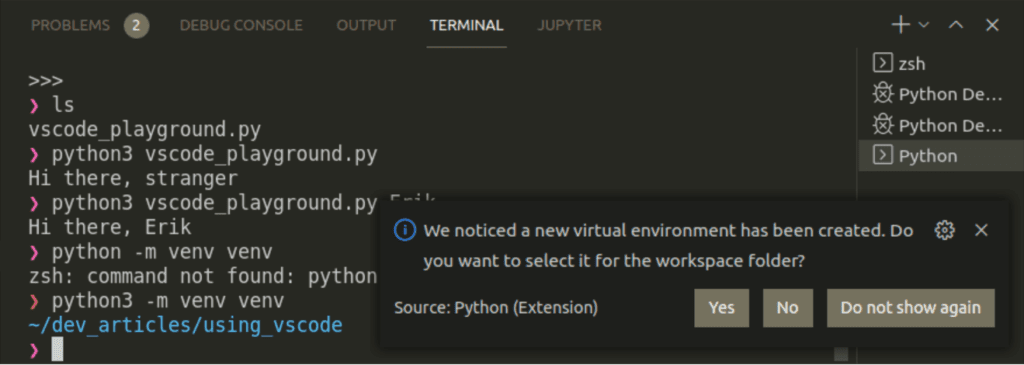
Click yes, and you're done! Alternatively, you can manually select this venv in the command palette (Ctrl+Shift+P) by typing 'select interpreter' and clicking on 'Python: select interpreter.'
Formatting Python in VSCode
You can format Python in VSCode if you lot hit:
- Windows: Shift + alt + F
- Mac: Shift + Option + F
- Linux: Ctrl+Shift+I (that's an uppercase i).
- Or open the command palette (ctrl + shift + p) and start typing 'format document'.
VSCode by default formats the current certificate. If you haven't done so, information technology asks yous if y'all want to install a formatter similar autopep8, blackness, or yapf. Selection 1 (the default, if you lot are unsure), and allow it install.
From now on, if y'all press the format shortcut while editing a Python file, you'll observe that your file gets formatted according to the default rules of the formatter. If you lot desire to customize these rules, y'all will need to await up (eastward.1000. on Google) how to do that for the specific formatter you picked. Normally, you can add together or modify rules by creating a specific file in your projection's chief directory.
Saving a workspace
Finally, you might want to save your workspace. It's not necessary, though. You tin just open the folder again. Customizations like your launch configurations are kept in the (subconscious) .code directory, and VSCode will detect this if you open the folder. Nevertheless, if you opened multiple folders in your workspace and don't desire to repeat those steps continually, yous can save the workspace using the File -> Salvage Workspace Equally.. menu.
Keep learning
Read these manufactures to learn more well-nigh Visual Studio Lawmaking and its features:
- Installing Python properly
- Why you should use an IDE for Python programming
- How to install VSCode
- A bout of the VSCode GUI
- VSCode Python extensions
The following external link might be helpful too:
- Official VSCode documentation
 Thank you for reading my tutorials. I use ads to proceed writing gratuitous manufactures, I hope you empathize! Back up me past disabling your adblocker on my website or, alternatively, buy me a coffee.
Thank you for reading my tutorials. I use ads to proceed writing gratuitous manufactures, I hope you empathize! Back up me past disabling your adblocker on my website or, alternatively, buy me a coffee.
Source: https://python.land/creating-python-programs/python-in-vscode
0 Response to "Configuration Is Still Incorrect. Do You Want to Edit It Again? In Python"
Post a Comment